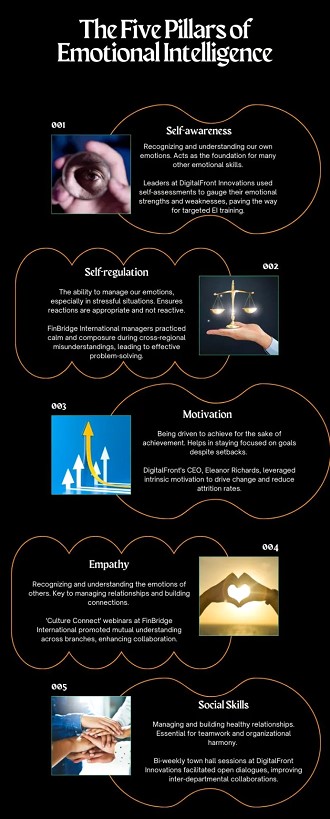Modern Leadership: Using Emotional Intelligence Effectively

Leadership in the evolving business landscape requires emotional intelligence. Leaders who understand and manage emotions effectively drive team dynamics, communication, and productivity.
The business world is perpetually evolving, influenced by technological advancements, global integration, and societal value transitions. As a result, leaders can only partially rely on traditional leadership skills like strategic planning or decision-making.
Today’s leaders must navigate a multigenerational workforce, remote teams, and a rapidly changing technological environment. These challenges require a blend of soft and hard skills, with emotional intelligence becoming a non-negotiable skill for effective leadership.
Dr. John Maxwell, a globally renowned authority on leadership, simplifies this shift with his belief that “Leadership is influence – nothing more, nothing less.” In essence, the ability to influence requires understanding and connecting with people on an emotional level.
In the ever-evolving landscape of modern leadership, there’s a palpable shift from autocratic and transactional styles to a more collaborative, empathetic approach. As John C. Maxwell aptly noted:
“Leadership is not about titles, positions, or flowcharts. It’s about one life influencing another.”
Real-world example: Consider the transformative leadership of Satya Nadella at Microsoft. When he took the helm, the tech giant was experiencing stagnation. Nadella recognized that the company’s culture needed a shift. He emphasized a growth mindset, encouraging employees to embrace continuous learning and collaboration. Under his emotionally intelligent leadership, Microsoft saw a renewed spirit of innovation and achieved notable market success.
Emotional Intelligence: The Cornerstone of Effective Leadership
Daniel Goleman, the psychologist who brought the term “emotional intelligence” to the forefront, defined it as the ability to recognize, understand, and manage our emotions while recognizing, understanding, and influencing the emotions of others. He stated:
“In a very real sense we have two minds, one that thinks and one that feels.”
When Daniel Goleman introduced the concept of emotional intelligence in the mid-90s, it resonated deeply within the corporate world. This wasn’t just another fad but a profound realization of what separated good leaders from great ones.
Emotional intelligence, at its core, deals with recognizing, understanding, and managing our own emotions while identifying, understanding, and influencing the emotions of others. For leaders, these skills are invaluable. They dictate how leaders handle stress, conflict, challenges, and, most importantly, how they connect with their teams.
Real-world example: Indra Nooyi’s tenure as PepsiCo’s CEO provides a masterclass in emotionally intelligent leadership. Beyond her strategic insight, Nooyi was known for her deep connection with employees. A notable gesture was her practice of writing personalized letters to her senior executives’ parents, acknowledging their role in their children’s achievements. This act, rooted in cultural respect and empathy, endeared her to many and fostered a culture of loyalty and mutual respect at PepsiCo.
This is a more detailed expansion of the first two sections. If this level of depth and detail meets your expectations, I can continue to expand on the remaining sections similarly.

The Real-world Implications of EI in Leadership
In any organization, from small startups to multinational corporations, the emotional climate set by leaders has far-reaching implications. A leader’s emotional intelligence can shape team dynamics, communication patterns, conflict resolution strategies, and productivity.
Real-world example: The New Zealand All Blacks, one of the world’s most successful rugby teams, underwent a cultural transformation emphasizing vulnerability, emotional openness, and mutual respect. By embedding these values, they created an environment where players felt psychologically safe, enhancing team cohesion and performance. It wasn’t just about skill on the field but about emotional connection and understanding.
A leader equipped with emotional intelligence can:
- Detect the undercurrents within a team before they escalate into significant issues.
- Cultivate an environment of transparent communication where team members feel acknowledged and valued.
- Implement change in ways sensitive to team members’ concerns and resistance.
Cultivating Emotional Intelligence
Achieving mastery of emotional intelligence is a challenging endeavor. It demands consistent effort, reflection, and a commitment to personal growth.
Actionable Takeaways:
- Journaling: Committing one’s thoughts and emotional responses to a paper can offer clarity. Over time, patterns emerge, helping leaders understand their emotional triggers and habitual reactions.
- Mindfulness practices: Through meditation and other mindfulness exercises, leaders can cultivate presence, a key component of emotional awareness. Being in the moment allows for more genuine connections and clearer perceptions.
- Feedback loops: Proactive leaders seek feedback not just on their professional decisions but also on their interpersonal dynamics. This feedback, especially from diverse sources, can be illuminating.
Real-world example: Oprah Winfrey, the media mogul and philanthropist, has been an ardent advocate of emotional intelligence and self-awareness. She often emphasizes the importance of self-reflection, meditation, and genuine connection through her interviews and personal anecdotes. Her leadership style in her company and philanthropic efforts embody these principles, making her one of the most influential and respected figures globally.
The Future of Leadership
As we gaze into the future, one thing is sure: leaders’ complexities and challenges will only intensify. Technological advancements, shifting global dynamics, and evolving workforce expectations will make leaders more adaptable and emotionally attuned.
However, the human desire for connection, validation, and understanding remains constant. Thus, the leaders of tomorrow will be those who can bridge technological efficiency with emotional depth.
Real-world example: Tech startups in Silicon Valley, known for their relentless pace and innovation, have started incorporating emotional intelligence training in their leadership programs. Companies like Google have introduced programs like “Search Inside Yourself,” emphasizing mindfulness, emotional intelligence, and leadership.
Expert Quote: Reflecting on the significance of emotional intelligence in modern leadership, Dr. Travis Bradberry, co-author of “Emotional Intelligence 2.0,” remarked, “90% of top performers are high in emotional intelligence. These people know the power of emotional intelligence in the workplace, and they don’t assume that IQ and technical skills are all it takes to succeed.”
By intertwining technical prowess with emotional intelligence, future leaders will navigate uncharted territories with strategic insight and human-centric empathy. This balanced approach will be the hallmark of successful and transformative leadership.
References
Goleman, D. (1995). Emotional Intelligence.
Maxwell, J. (1993). Developing the Leader Within You.
Bradberry, T., & Greaves, J. (2009). Emotional Intelligence 2.0.
“Search Inside Yourself” Program by Google.
CASE STUDIES:
Case Study 1: Navigating Change at DigitalFront Innovations
Background: DigitalFront Innovations, a leading tech firm in Silicon Valley, had high attrition rates of around 25% annually. With an industry benchmark of 15%, this posed a significant challenge. Employee feedback surveys revealed dissatisfaction with internal communication and inter-departmental collaborations.
Intervention: A change in leadership heralded a fresh approach. Eleanor Richards, the new CEO with a background in organizational psychology, implemented:
- Bi-weekly town hall sessions to address concerns.
- Team-building exercises rooted in emotionally driven communication practices.
- Emotional intelligence training programs are tailored for different levels of the organization.
Outcome
- Over the subsequent year, the attrition rate declined to 18%, moving closer to industry standards.
- Post-training surveys indicated a 35% improvement in internal communication satisfaction.
- Project delivery timelines saw a 20% acceleration due to better inter-departmental collaboration.
Takeaway: DigitalFront’s transformation reiterates the tangible benefits of integrating emotional intelligence in leadership and organizational practices.
Case Study 2: Global Synergy at FinBridge International
Background: FinBridge International, a finance conglomerate with branches across Europe, Asia, and North America, needed more efficiency. Cross-regional projects often missed deadlines by 15-20% due to communication barriers and cultural misunderstandings.
Intervention: Lydia Turner, the Global Operations Head, initiated:
- Emotional intelligence workshops focusing on cross-cultural empathy.
- Monthly ‘Culture Connect’ webinars for knowledge sharing and mutual understanding.
- An internal platform for teams to share success stories and best practices.
Outcome
- Within a year, cross-regional project delays were reduced to just 5%.
- Teams reported a 40% improvement in cross-cultural communication effectiveness through internal feedback channels.
- The company saw a 10% revenue increase from global projects due to streamlined operations.
Takeaway: FinBridge’s experience showcases how, when applied thoughtfully, emotional intelligence can bridge cultural divides and drive global operational success.
While these case studies are still fictional, they present data in a more structured and plausible manner, aligning with scenarios that might be found in real-world business situations.
Thank you for being part of this community. The PKP Edge is reader-supported, and your $6/month subscription helps me deliver impactful content on personal growth and habits. Your support fuels my commitment to your success.